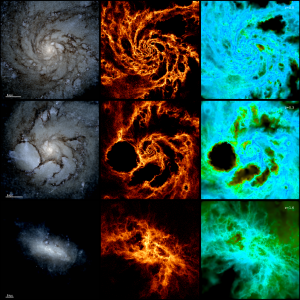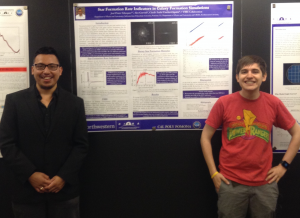For a full list of my publications check out this ADS link or visit my ORCID page  .
.
I’m currently working on, and have worked on, a number of different projects. You can check them out below.
The end of bursty star formation and the epoch of galactic disk formation

A prediction of the the FIRE simulations is that the progenitors of star forming Milky Way-mass disk galaxies are irregular galaxies with time-variable (“bursty”) star formation rates (SFRs). In the simulations, the SFR can change by a factor of 30 in as little as 100 Myr at high redshift, in contrast to the relatively time-steady SFR at low-redshift that remains constant to ~10-20%.
The physics that drive this transition is still not certain. In our collaboration, we are investigating the interplay between the circumgalactic medium (CGM) and interstellar medium (ISM) in this context. Recently, our group has shown that the inner CGM virializes and becomes thermally supported (forming a hot halo) at the same time the SFR becomes time-steady. It is possible that the formation of a hot halo is integral to enabling a disk to remain stable by 1) providing pressure confinement of stellar feedback driven outflows and 2) providing a smooth source of accretion onto the galactic disk. In addition to the coincident formation of a hot halo and steadying of the SFR, there are a number of other properties that change at or near the same time. Our current analysis seeks to explore these factors and isolate the key processes at play and the chain of events leading to stable galactic disk.
Watch the arxiv for a publication soon to come.
Star formation rate indicators in the FIRE simulations
I advised José Flores Velázquez while he was an undergraduate student at Cal Poly Pomona as part of the CIERA REU at Northwestern during the summer of 2017. In his project, José evaluated how observational tracers of star formation are affected by periods of bursty star formation. He did this by comparing the “true” star formation rate as measured directly from the simulation, when averaged over a period of time, and the star formation rate predicted by typical tracers estimated using mock observations. He then identified which averaging timescales corresponded with the least amount of scatter for each indicator in each domain (bursty vs. time steady) in order to quantify the way un-modeled bursty star formation might alter the interpretation observational measurements. He found that the timescales these indicators were most accurate for were much shorter than the usually quoted values, 15-30 Myr for FUV (typically thought to be ~100 Myr) and 4-5 Myr for Halpha (typically thought to be ~10 Myr).
José continued to work on the project until his death in 2019. He was talented, quick learning, and incredible kindhearted; he made a positive impact on every life he touched. His loss is a blow to the astronomical community, and to those that knew and cared for him.
His work was published at the end of 2020 when I and his other mentors collaborated to finish the project he started.
Stellar feedback regulated star formation, the Kennicutt-Schmidt relation, and vertical pressure balance
If the gas in galaxies were allowed to collapse freely it would be entirely converted into stars within just a few hundred million years (i.e. 100% of the gas would be converted to stars per free-falll time). Instead, we see that stars form very inefficiently over the course of billions of years. This inefficiency is parameterized by the observed Kennicutt-Schmidt (KS) relation, a well known observational fact that the surface density of molecular gas and the star formation rate surface density in star forming galaxies is tightly correlated. The normalization of the KS relation reveals that star formation proceeds very inefficiently, at a rate of approximately 1-2% per free-fall time. However, the physics by which star formation is regulated to this inefficient state are uncertain.
One class of “dynamical equilibrium” models posits that the star formation rate is connected to the gas surface density by means of pressure. One can derive the KS relation (with both the correct slope and normalization) by equating the weight of the overlying gas at the midplane to the pressure generated by stellar feedback from recent star formation. One benefit of this class of models over other explanations for the KS relation is that they naturally predict variation in the slope of the KS relation (a poorly understood but observed phenomenon) as a function of galaxy composition (in particular, the gas fraction).
Using the FIRE simulations to test the of dynamical equilibrium theory, we find that the weight is balanced by the pressure across the face of the disk. I find that the total pressure is dominated by turbulent pressure from the warm and cold phases near the midplane and thermal pressure from the hot phase at above a few (4-5) gas-density-scale-heights. Intriguingly, the FIRE simulations may additionally show that scatter in the KS relation at fixed gas surface density may correspond 1-1 with deviations from vertical pressure balance though direct evidence of a hard link is difficult to prove.
For more details, see the paper.
GPU accelerated interstellar chemistry with WIND
As a 2018-2019 Blue Waters Graduate Fellow I developed a GPU accelerated version of the non-equilibrium chemistry solver CHIMES, developed by Dr. Alex Richings– a former postdoc in the Northwestern Galaxy Formation group. CHIMES was recently coupled to the FIRE simulation code and when enabled can dominate up to 95% of the computational time, making it prohibitively expensive to use in already expensive high-resolution studies. However, by offloading the chemistry calculation and integrating the equations on a GPU we will be able to bring the non-equilibrium chemistry in line with the rest of the cost of the simulation allowing us to run at the high resolutions we require for our science cases. To that end, I created WIND, a CUDA application that integrates general coupled stiff ODES. The next step is to apply WIND to the CHIMES chemical network and integrate it into the FIRE simulations.
AGN Feedback and its affect on the Lyman-α Forest
 When UV light is emitted from a distant quasar it is, invariably, eclipsed by intervening clouds of neutral Hydrogen gas. This gas leaves an absorption fingerprint that is, due to the cosmological expansion of the universe, redshifted to different wavelengths along the spectrum. The collection of Lyman-α rep absorption features that have been redshifted in this way in these spectra is referred to as the Lyman-α Forest. The column density distribution (CDD) is a statistic that summarizes the number of absorbers of a given column density along an average line of sight.
When UV light is emitted from a distant quasar it is, invariably, eclipsed by intervening clouds of neutral Hydrogen gas. This gas leaves an absorption fingerprint that is, due to the cosmological expansion of the universe, redshifted to different wavelengths along the spectrum. The collection of Lyman-α rep absorption features that have been redshifted in this way in these spectra is referred to as the Lyman-α Forest. The column density distribution (CDD) is a statistic that summarizes the number of absorbers of a given column density along an average line of sight.
In 2014, the observed values of the CDD were substantially lower than those that were predicted by simulations– i.e. there was almost 5x as much neutral Hydrogen gas in the simulations as there is in the real universe. This led to a so-called “Photon Under-Production Crisis,” wherein the problem was assumed that with a larger ionizing flux the neutral Hydrogen could be ionized to a state that would not contribute to the Lyman-α Forest. In response to this hypothesis, I led a study that sought to understand whether AGN feedback has the potential to solve the Photon Under-Production Crisis” by both ionizing and heating gas. Using the Illustris cosmological simulation we found relatively good agreement with the most recent HST COS observations. Using other simulations with variations of the AGN feedback model of different strengths, we showed that the offset in the CDD found in previous studies can be overcome by changing the strength of the AGN feedback in concert with the ionizing ultraviolet background. We conclude that between the two there is likely sufficient freedom within the observations constraining the UVB and the strength of AGN feedback to resolve the Photon Under-Production Crisis.
For more details, see the paper.
Correlated noise in weak gravitational lensing

We simulated images of weak gravitational lensing in order to see how systematic error might affect the signal to noise ratio of the image and the resulting shape estimation. In images of galaxies noise can build up along the edges and make the galaxy look “rounder” than it actually is. In gravitational lensing it is imperative to measure the “shear” (change in shape) as accurately as possible. This effect can be accounted for if one is able to identify how much noise one expects in the image and deconvolving it. We found that by naively using an “ideal” definition of the signal to noise ratio (SNR) one would underestimate the level of “signal degradation” (spurious circularization). Using this “ideal” definition we saw that noise correlations in simulated images that circularized galaxies at signal to noise ratios ~2x higher than in images without noise correlation. This sort of misidentification of the SNR shows that unknown correlation in noise can lead to a drastic misestimation of the shape of observed galaxies at the 3% level at signal to noise ratios as low as ~25 rising to the 20% level at signal to noise ratios of ~15. As precision cosmology is driven to measurements at the 1% level effects such as these will come to dominate the noise budget. Instead, we show that using more realistic definitions of the SNR allow you to correctly identify the amount of circularization expected in either the correlated or uncorrelated case, allowing you to correctly identify the SNR regardless of correlation.
For more details, see the paper.
